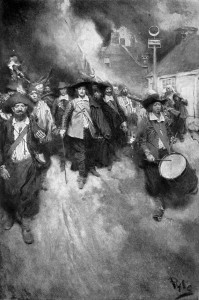
Arguably, the greatest year in American history was 1776. It was during this year that the seeds of liberty were planted and they would be officially harvested in 1783. The Declaration of Independence was established in 1776 and Washington’s decisive victory at Trenton also occurred in this year. However, one hundred years before this monumental year there was another, lesser known, rebellion that did not grow into a revolution but did, to keep with the planting metaphor, plant the seeds of the liberty of 1776.
In 1676, Nathaniel Bacon led his revolt against Virginia governor William Berkeley. Bacon and his supporters protested unfairly levied taxes but mostly, Berkeley’s incompetence and his refusal to protect the Virginia frontier from Native American attacks. Berkeley’s Indian Policy was the underlying cause for Bacon’s uprising. Bacon and his “army” of Virginia farmers and villagers rose up against the “tyranny” of Berkeley.
In September, Bacon’s army burned Jamestown, Virginia to the ground and attempted to overthrow the Virginia government. Bacon died of dysentery in October and John Ingram, his successor, failed to continue the rebellion. Berkeley defeated him in several important engagements around the Chesapeake Bay and soon the rebellion was crushed.
Although the rebellion was short lived it was large enough to catch the attention of King Charles II of England. He recalled Berkeley after the uprising and replaced him with Herbert Jeffries. The rebellion did have a profound effect on the colonies leading up to the Revolution. Before his death, Bacon declared a “Declaration”, listing his grievances with Berkeley, similar to Jefferson’s in 1776. The reasons cited by Bacon for his uprising were some of the same cited by the Founding Fathers in 1776. These included: taxes, incompetence and administrative abuses and frontier issues such as the Quebec Act.
